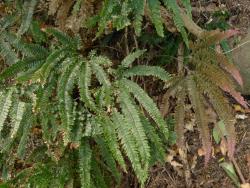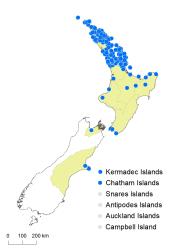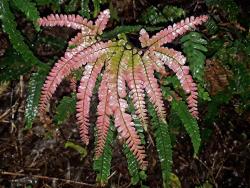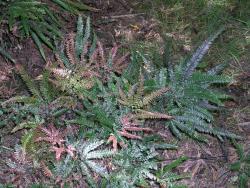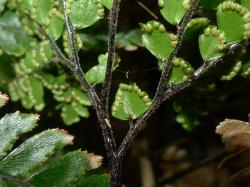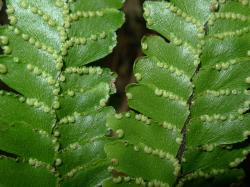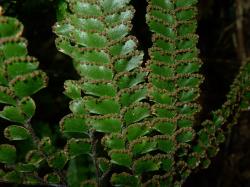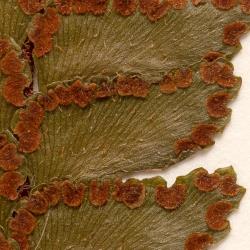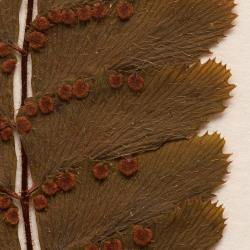- = Adiantum pedatum G.Forst., Fl. Ins. Austr. 83 (1786) nom. illeg., non Adiantum pedatum L. 1753
- ≡ Adiantum pubescens Schkuhr, 24. Kl. Linn. Pfl.-Syst. 1, 108, t. 116 (1809) nom. nov. pro Adiantum pedatum G.Forst. 1786
- ≡ Adiantum hispidulum var. pubescens (Schkuhr) Large & Braggins, New Zealand J. Bot. 31: 416 (1993)
Rhizomes short-creeping or erect, up to 30 mm long (in herbarium material), up to 2 mm diameter, with stipes closely inserted; stoloniferous; bearing scales; stolons and tubers absent. Rhizome scales narrowly triangular, 0.9–3.0 mm long, 0.2–0.4 mm wide, dark brown, concolorous. Fronds 100–730 mm long. Stipes 30–450 mm long, dark brown, bearing scattered scales proximally and abundant antrorse hairs distally. Rachises red-brown; bearing abundant, short, pale brown, antrorse hairs, and a few scattered, straight, dark brown hairs to 1.5 mm long. Laminae helicoid or 2–3-pinnate, broadly ovate or broadly elliptic or orbicular or broader than long, 55–285 mm long, 45–340 mm wide; dark green on both surfaces, tinged red in immature fronds, coriaceous, bearing stiff whitish hairs 0.1–1.0 mm long on both surfaces; costae bearing pale brown antrorse hairs on both surfaces. Primary pinnae narrowly elliptic or narrowly ovate or ± linear, 20–280 mm long, 8–35 mm wide, apices acute or acuminate, bases stalked. Longest ultimate segments oblong, 6–23 mm long, 3–7 mm wide, apices acute to obtuse, acroscopic margins regularly lobed, basiscopic margins entire, bases stalked, with stalks attached in one corner. Reflexed lamina flaps reniform, hairy.
Adiantum hispidulum can usually be distinguished from all other maidenhair ferns in New Zealand by its characteristic helicoid branching. A few plants are regularly 2–3-pinnate, and these may be confused with divided forms of A. diaphanum, but they can be distinguished by their more divided laminae and lack of tubers on the rootlets. Young fronds are also often tinged red when young.
Adiantum hispidulum is dimorphic with respect to the nature of the hairs on the abaxial surface of the laminae. Most plants have short, stiff hairs 0.1–0.8 mm long, but a few have longer, lax hairs 0.3–1.0 mm long. Parris (1980) recognised the former as A. hispidulum and the latter as A. pubescens Schkuhr. However, in a detailed investigation of the two taxa, Large & Braggins (1993) found that the two taxa could only be distinguished on the basis of their hair characters, and even then there was a high degree of variability. They treated A. pubescens as a variety of A. hispidulum, and the dimorphic nature of the species can be recognised at this rank if required.
Var. pubescens has a slightly different distribution to that of var. hispidulum. It is the only form that has been collected on the Kermadec Islands. Otherwise it is confined to Northland, with isolated populations at Pouto, Kaipara Harbour and Piha (Parris 1980). Its distribution in this area overlaps entirely with var. hispidulum, but it does not extend to the rest of the North Island or the South Island.
North Island: Northland, Auckland, Volcanic Plateau, Gisborne, Taranaki, Southern North Island.
South Island: Sounds-Nelson, Canterbury.
Kermadec Islands, Three Kings Islands, Chatham Islands.
Altitudinal range: 0–400 m.
Adiantum hispidulum occurs on the Kermadec and Three Kings Islands, and in lowland areas of the North Island from Te Paki to Wellington. It is common from Te Paki to Auckland and the Bay of Plenty, but there are only scattered records on the west coast south to Wellington. It grows from near sea level, reaching 400 m on Mt Pirongia. In the South Island there are two collections in the Armstrong Herbarium from Governors Bay, Lyttleton Harbour (CHR 633291), and from Akaroa (CHR 633292), both collected about 150 years ago. Allan (1961) recorded it from D’Urville Island, but the specimen (CHR 62007) has been re-determined as A. fulvum (Beever et al. 1989). Allan also recorded it from Bishopdale, near Nelson, and from Seaview, Dunedin, but no supporting herbarium specimens have been located. Recently, it has been collected from near Richmond and reported from East Tākaka (Jones 2019). The species also occurs on the Chatham Islands.
Also southern Africa, southern India, Asia, Malesia, Australia (Western Australia, Northern Territory, Queensland, New South Wales, Australian Capital Territory, Victoria), Norfolk Island (as A. pubescens), Lord Howe Island, Vanuatu, New Caledonia, Fiji, Tonga, Cook Islands, French Polynesia and Pitcairn Island. It is naturalised in North America (Windham 1993), Europe (Fraser-Jenkins et al. 2017), and Hawai‘i (Palmer 2003).
Adiantum hispidulum grows on the ground under podocarp, broadleaved, beech and coastal forest, under mānuka and kānuka, in coastal scrub, and under pines. It is found on streambanks, amongst rocks and in crevices, on cuttings, on rock overhangs and rocky banks, in clearings and on bush margins, on dry hillsides and grassy slopes, on sandy banks, and on coastal cliffs.
n = c. 174 (Brownlie 1957), 2n = c. 160–173, possibly apomictic (Large 1984).
Further investigation is required to ascertain whether the differences in hair type on the abaxial lamina surfaces of A. hispidulum correlate with genetic differences in different parts of its extensive geographical range.



